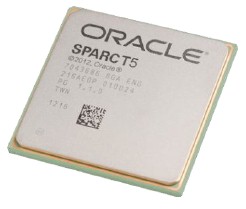 Oracle SPARC T5 | |
| General information | |
|---|---|
| Launched | 2013 |
| Discontinued | 2017 |
| Performance | |
| Max. CPU clock rate | 3.6 GHz |
| Cache | |
| L1 cache | 16×(16+16) KB |
| L2 cache | 16×128 KB |
| L3 cache | 8 MB |
| Architecture and classification | |
| Technology node | 28 nm |
| Instruction set | SPARC V9 |
| Physical specifications | |
| Cores |
|
| Products, models, variants | |
| Core name |
|
| History | |
| Predecessor | SPARC T4 |
| Successor | SPARC M7 |
SPARC T5 is the fifth generation multicore microprocessor of Oracle's SPARC T series family. [1] It was first presented at Hot Chips 24 in August 2012, [2] and was officially introduced with the Oracle SPARC T5 servers in March 2013. [3] The processor is designed to offer high multithreaded performance (16 cores per chip, with 8 threads per core), as well as high single threaded performance from the same chip. [4]
Contents
The processor uses the same SPARC S3 core design as its predecessor, the SPARC T4 processor, but is implemented in a 28 nm process and runs at 3.6 GHz. [5] The S3 core is a dual-issue core that uses dynamic threading and out-of-order execution, [6] incorporates one floating point unit, one dedicated cryptographic unit per core. [7]
The 64-bit SPARC Version 9 based processor has 16 cores supporting up to 128 threads per processor, and scales up to 1,024 threads in an 8 socket system. [4] Other changes include the support of PCIe version 3.0 and a new cache coherence protocol. [5]
